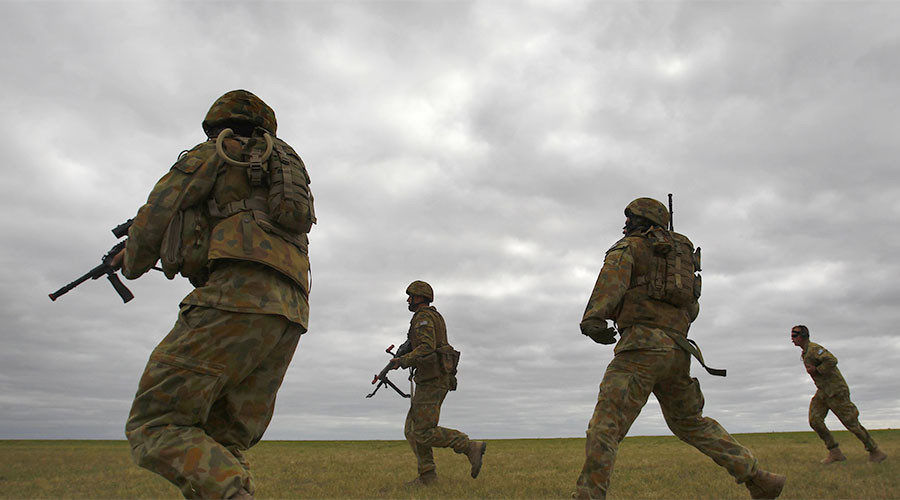
© Mick Tsikas / ReutersMembers of Australia's special forces
Australian elite special forces are under investigation for the possible unlawful killings of civilians in Afghanistan, including of a six-year-old child, according to leaked government documents.
The papers also reveal details of a hand-severing incident involving the SAS.Details of the killings are included in leaked Australian Defence Force documents totalling hundreds of pages, many of which were marked "AUSTEO" (Australian Eyes Only).
The documents were leaked exclusively to the Australian Broadcasting Corporation (ABC), and have been referred to as"
The Afghan Files" by the news outlet.
At least two of the potentially unlawful killing incidents are being investigated by the Inspector General of the Australian Defence Force, as part of a wider probe into the conduct of special forces in Afghanistan.One of those incidents involves the deaths of a man and his six-year-old child during a raid. The Afghan boy was hidden in blankets near a target sought by Australian troops, thought to be a Taliban member. Australian forces managed to kill their target, but also inadvertently killed the child with a single gunshot wound to the abdomen. The child's family received a compensation payment of US$1,500.An inquiry found that there was insufficient evidence to conclude that the alleged Taliban target was actually part of the group, or an insurgent at all. However, it also concluded that the Australian soldiers had fired in self-defense and exercised appropriate restraint. The case has been referred to the Inspector General's inquiry.
Another case mentioned is the killing of a detainee who was alone with an Australian soldier and allegedly tried to seize his weapon.
Both of the incidents being investigated occurred in September 2013.
ABC
listed a number of other cases of civilian deaths at the hands of Australian troops in Afghanistan, along with the outcomes of various inquiries that were launched. A US helicopter airstrike that killed two Afghan boys and three donkeys instead of insurgents after being called in by Australian troops is one of them.
Severed handsThe
documents also shed additional light on the severing of hands by an SAS corporal, which was initially revealed by the ABC in 2013.
According to the documents, special forces were in search of a target codenamed "Objective Rapier," an insurgent commander responsible for numerous attacks, in April 2013. A total of 120 soldiers were involved in the operation, including troops from the Special Air Service (SAS) and commandos.
Four insurgents were killed in the southern province of Zabul during the operation, with an SAS corporal searching the first body and finding a Makarov pistol.
"[He] then severed a single hand of the EKIA (enemy killed in action) with a scalpel," a report of the inquiry into the matter says, according to ABC.
The soldier then repeated those actions with two others, cutting off their right hands.
"At this point in time patrol commander (a sergeant)... arrived at EKIA 3, and seeing the two hands on the ground, exclaimed words to the effect: 'What the f**k are you doing?'" the report states. The patrol commander later told investigators that the soldier who chopped off the hands was "speechless," but that his colleague said it was a "tactical necessity...""...This is a procedure to conduct latent fingerprints in the laboratory to take explosive residues."In yet another twist, a training session which took place just nine days before the incident, conducted by an Australian Defence Force Investigative Service (ADFIS) sergeant and a civilian fingerprint expert, is revealed in the documents.
Some SAS members who attended the training claim the two training leaders said the removal of hands was allowed, with one SAS trooper reportedly calling it the "gold plate solution."
While the civilian fingerprint expert claims he had only discussed body parts being examined in the context of "post-blast" investigations and has denied ever discussing the severing of hands, the ADFIS sergeant tells a different story.
The sergeant admitted that the subject of severing hands had come up, and agreed that it would be a good method of securing fingerprints. However, he reportedly cautioned the SAS members to ask their superiors whether it was acceptable.
He also said he wasn't surprised that the SAS members left the training believing the severing of hands was allowed, as "that was all they were focused on."
The incident led the commanding officer of the SAS regiment to write to the head of ADFIS, accusing ADFIS investigators of attempting to save face when it came to their colleague, even if it was at the expense of the SAS.
As the investigation deepened, it reportedly became clear that Australian troops stationed in Afghanistan had not been explicitly told whether the collection of body parts of biometric testing was allowed. This prompted new guidelines to be implemented, stressing that "the mutilation and otherwise maltreatment of human remains" is not permitted.To this day, more than four years after the incident, it remains unclear whether any action was taken against the SAS trooper who severed the hands.
Meanwhile, the documents also refer to
tensions between the SAS and the 2nd Commando Regiment, the two most prestigious units within the Australian army, and recall a moment when an SAS trooper pulled a gun on a female Australian Secret Intelligence Service (ASIS) officer.
The information revealed by the ABC is part of a seven-part series based on the leaked documents.
Reader Comments
to our Newsletter